
Oceana Golf Club
Since 1962, this is Oceana County’s original 18-hole public course. Oceana Golf Club is known for having the best greens in the area.
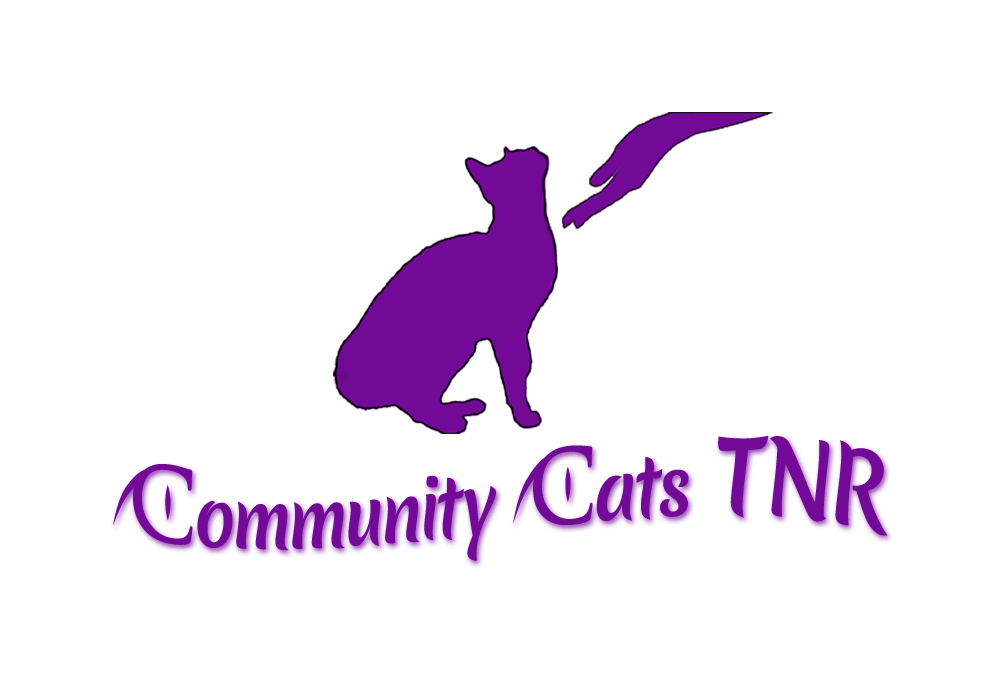
Community Cats TNR is a group of volunteers, caregivers, and veterinarians working in the City of Ludington and Mason County, Michigan to reduce and stabilize the number of free-roaming, abandoned, homeless, feral cats through a humane program known as Trap-Neuter-Return (TNR).
The success of the Community Cats TNR program relies on direct monetary and memorial contributions. Community Cats TNR is a 501c3 public charity. Donations are tax-deductible to the extent allowed by law.
Community Cats TNR volunteers meet with caregivers, assess the size, ages, health of their cats, provide them with information on how our program works, show them how to safely and successfully trap the cats, and how to care for cats before and after surgery. We schedule the veterinary appointment and help trap the cats the day before surgery. The next day, we transport the cats to and from the clinic.
Country Veterinary Clinic provides time in their surgery schedule for Community Cats. In addition to spay/neuter surgery, the cats receive a general health check, are treated for parasites, given rabies and distemper vaccinations, flea/ear mite treatment, pain medication and the left ear is tipped for identification purposes. After surgery, cats are cared for in the traps either by the caregiver, or by one of our volunteers. Males are generally returned and released the next day and females are generally kept for two or three days. Kittens over three pounds (about 12+ weeks old) can be spayed/neutered.
We find that after TNR, the cats are healthier, recover quickly and caregivers are appreciative that they won’t be producing any more kittens. The cats are staying closer to their feeding areas because the males in particular aren’t inclined to roam. Neighbors have reported a huge reduction in spraying and mating noises and behavior. Most of the cats are somewhat trusting of people because caregivers talk to them and sometimes are able to pet them a bit. There are some, however, that are very frightened and will scratch or even bite. We teach caregivers to never trust a frightened cat, always keep them in the trap before and after surgery, and always use the divider when cleaning the trap or replacing food and water.
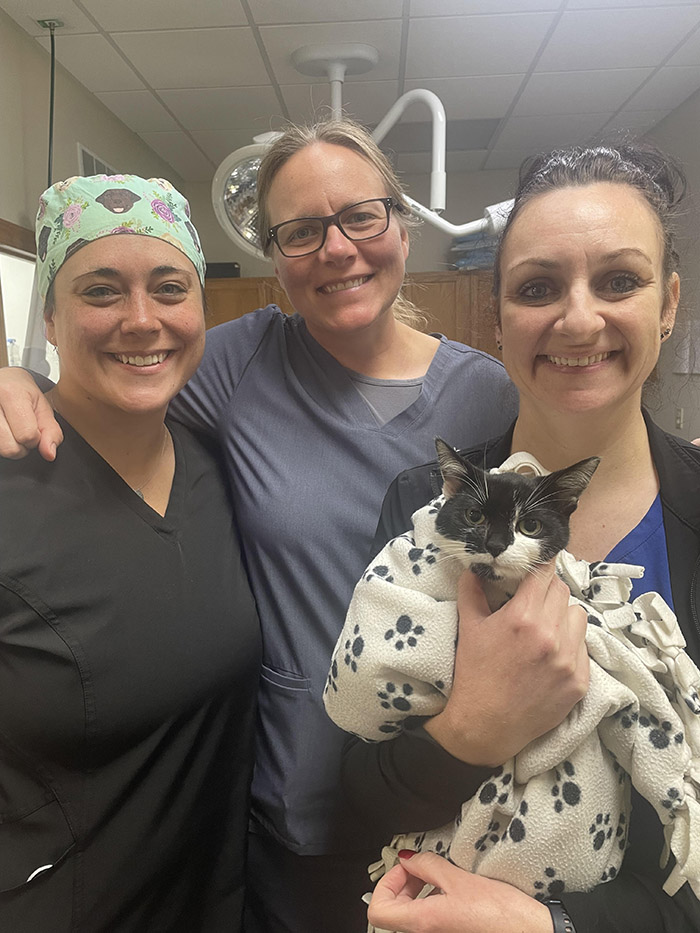
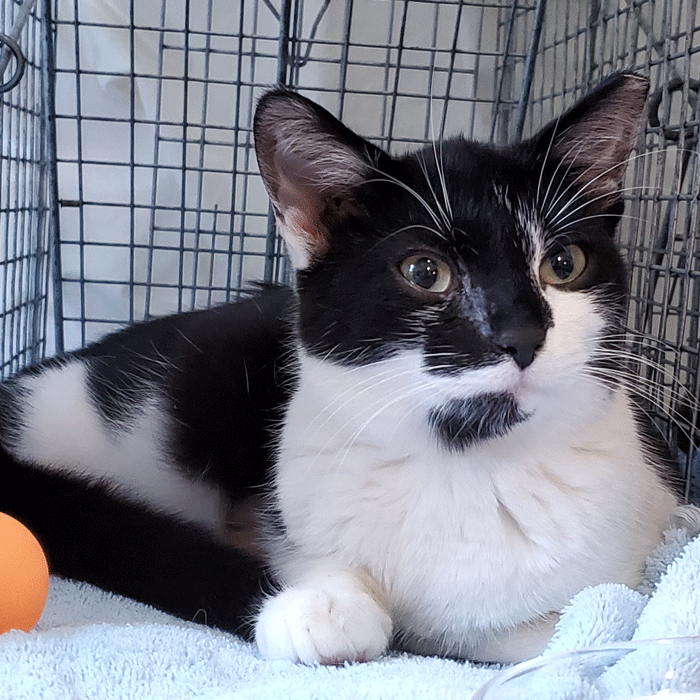
You can download our 2023 newsletter here.
We are currently assisting a family trying to relocate a feral cat colony, find homes for four kittens and one house cat due to the death of the caregiver. If you can adopt any of these cats, please call 845-7888.
Caregivers who are feeding and caring for homeless cats are encouraged to continue providing care for them. Community Cats TNR continues to need additional donations of dry and canned cat food dropped off in the box at Family Fare (formerly Shop N Save) to help increased demand from caregivers. Check out the new donation box at Family Fare, designed and built by Mike and Adrianne. Awesome job!
NEWS STORY – Ludington Daily News and Mason County Press For Immediate Release
Date: November 12, 2023
CONTACT: by Joanne Kelley, Community Cats TNR Treasurer
231-845-7888 or 231-590-7175
Community Cats TNR, a local, non-profit group of volunteers, in partnership with Country Veterinary Clinic, P.C. has Trap-Neuter-Returned (TNRd) 1,500 Community Cats as of November 7, 2023.
Cat number 1,500 is a spunky black and white female, about 6 months old. She comes from a large feline family in the Tallman/Walhalla area of Mason County. She was spayed and vaccinated by Dr. Alex Alvarado, DVM of Country Veterinary Clinic.
During the past eleven years, volunteers for the Community Cats TNR program have been working with caregivers to Trap-Neuter-Return (TNR) homeless cats, primarily in urban locations, throughout Mason County. Based upon calculations by the University of Washington Math Department, females TNRd so far by Community Cats TNR could have produced approximately 330,000 unwanted kittens in just seven years!
Trap-Neuter-Return, commonly referred to as “TNR,” is the only method proven to be humane and effective at controlling feral cat population growth. Volunteers focus on keeping the cats as stress-free as possible by monitoring the traps at all times and covering the trap when it closes to immediately calm the cat.
Community Cats TNR focuses on homeless cats that need to be trapped for safe handling and transport to the veterinary clinic. People who are caring for friendly strays are encouraged to arrange for surgery with their own veterinarian and to contact Fixing Furry Friends Facebook page to complete an application for a spay/neuter certificate to pay for a portion of the cost.
Caregivers in Mason County who are feeding homeless cats that cannot safely be handled are encouraged to call 231-845-7888 for more information on getting the colony spayed and neutered and vaccinated. Trap-neuter-return operations are paused during the late fall and winter months so cats are not subjected to cold weather survival and surgery recovery at the same time.
Warm shelter along with food and water is critical to the survival of outdoor cats throughout cold and wet weather. There are many ideas and designs available for winter cat shelters on www.alleycat.org, www.bestfriends.org, www.neighborhoodcats.org and many others. Above all shelters need minimal air space and plenty of straw for insulation. Community Cats TNR always needs ½” plywood, paneling or luan, and rigid “blue board” insulation, along with volunteers to build shelters. County wide there is a need for more foster homes and secure places to relocate cats faced with loss of a safe environment.
For more information, contact 845-7888. Donations can be made by check to Community Cats TNR, PO Box 384, Ludington, MI 49431 or by credit card by going to www.nfggive.org/donation/46-3759577 to complete the Network for Good form.
Quote from Joanne Kelley, Treasurer – “Community support for trap-neuter-return has been amazing and continues to increase every year. Thanks to all supporters and volunteers who make this program so successful.”
Community Cats TNR meeting is scheduled for 2pm on April 14, 2024 at 703 St Catherine Street, Ludington. Please come, join our group of dedicated volunteers, and lend your ideas!
As of December, 2023, we have spayed/neutered 1,516 cats resulting in the birth of approximately 334,000 fewer unwanted, homeless kittens!
The University of Washington’s Math Department calculated the reproductive potential of one female cat using the scientifically collected data from Dr. Michael Stoskopf’s population studies of feral cat colonies in North Carolina.
Here are the assumptions used for the population projection: One female cat gives birth to six kittens per year. Kitten gender is 50% female, and only 25% of kittens survive to reproductive age. All surviving female kittens become adults and reproduce with the same birth and kitten mortality rates. If no adult cats ever die, how many cats/kittens would there be at the end of seven years?
The consensus of five Math Department professors these experts based on these assumptions is this: One female cat and her offspring could produce between 100 and 400 cats by the end of seven years. (Source: Humane Society of the United States)
This calculation seems to assume that there will be only one litter per year for each female. We find that two litters per year are typical and some caregivers have reported three and even four litters per year. Based upon an assumption of two litters per year, we estimate that our count so far has prevented the birth of at least 334,000 kittens over the next seven years.
This program is a major commitment on the part of the volunteers of Community Cats TNR. It requires cooperation from all segments of the community, financial and volunteer support from residents and businesses and a commitment on the part of pet owners to get their cats spayed and neutered so that they don’t contribute to the problem. There are TNR success stories in communities all over the country – ours also can continue to be a success story!
Thank you from the Community Cats TNR Board of Directors – As the Community Cats TNR program enters its 12th year, we wish to thank all who have made donations, helped with and contributed to fundraisers, dropped loose change and bills in to canisters and the participating businesses that welcomed the canisters, to Shop N Save (now Family Fare) and all who have dropped off canned and dry cat food in the container, and individuals and businesses that have donated building materials, straw, and built winter cat shelters.
We encourage you to visit the following websites for information about cats in general and successful management and care of stray cats. The Neighborhood Cats TNR Handbook is very comprehensive and is a valuable resource. Other resources we utilize include the “Colony Care Guide” and “How to Live with Cats in your Neighborhood” provided by Alley Cat Allies and information on how to build (or purchase) winter cat shelters provided by Neighborhood Cats.
“The greatness of a nation and its moral progress can be judged by the way its animals are treated.”
~Mahatma Gandhi~
Trap-Neuter-Return (TNR) programs are being operated successfully by non-profits and municipalities throughout the country, and in Michigan. Numerous studies have shown that TNR IS THE ONLY METHOD PROVEN TO BE HUMANE AND EFFECTIVE AT CONTROLLING FERAL CAT POPULATION GROWTH.
Using this technique, all the feral cats in a colony are trapped, neutered and then returned to their territory where caretakers provide them with regular food, water and shelter. Ideally, young kittens who can still be socialized, as well as friendly adults, can be placed in foster care and eventually adopted out to good homes.
It immediately stabilizes the size of the colony by eliminating new litters. The nuisance behavior often associated with feral cats is dramatically reduced, including the yowling and fighting that come with mating activity and the odor of unneutered males spraying to mark their territory. The returned colony also guards its territory, preventing unneutered cats from moving in and beginning the cycle of overpopulation and problem behavior anew. Particularly in urban areas, the cats continue to provide natural rodent control. Another significant advantage to TNR is that it lessens the number of kittens and cats flowing into local shelters. This results in lower euthanasia rates and the increased adoption of cats already in the shelters.
A “feral” cat is a feline who lives outside a normal home and has to some extent reverted to a wild state. Ferals tend to be fearful of people and keep their distance unless the person is someone they have come to know and trust. They originate from lost or abandoned domestic cats who either became wild themselves after living on their own or parented feral offspring. In contrast to ferals, a “stray” is a lost or abandoned cat who still retains his tame nature.
Most cats living on their own are feral and live in groups called “colonies.” The cats in a colony share territory and a common food source. Often the cats in a colony are related by family, but not always. Feral colonies can form anywhere there is adequate food and shelter. The vast majority of ferals are not completely wild because they rely on people for their food source, whether it’s a restaurant dumpster or a kind neighbor who comes by once a day. Relatively few subsist by hunting alone.
A “feral” cat is a feline who lives outside a normal home and has to some extent reverted to a wild state. Ferals tend to be fearful of people and keep their distance unless the person is someone they have come to know and trust. They originate from lost or abandoned domestic cats who either became wild themselves after living on their own or parented feral offspring. In contrast to ferals, a “stray” is a lost or abandoned cat who still retains his tame nature.
Most cats living on their own are feral and live in groups called “colonies.” The cats in a colony share territory and a common food source. Often the cats in a colony are related by family, but not always. Feral colonies can form anywhere there is adequate food and shelter. The vast majority of ferals are not completely wild because they rely on people for their food source, whether it’s a restaurant dumpster or a kind neighbor who comes by once a day. Relatively few subsist by hunting alone.
Age – Usually, kittens six to seven weeks of age or younger are not yet developed enough to be highly feral and can easily be socialized within a matter of days. As the kitten progresses it is increasingly difficult with each passing week.
Number of generations feral – Cats grow wilder with each succeeding feral generation. For example, a cat who herself once lived in a domestic home will tend to be less feral than her offspring, while a tenth generation feral cat will tend to be wilder than one who is second generation.
Amount of human contact – The amount of contact the cats have with people on a regular basis is another important factor. A cat who lives in a community garden and has visitors coming everyday to talk and play with him will be less feral than a cat who lives in the woods and rarely encounters people.
Personality – On rare occasions, a feral cat is naturally friendly towards people despite being beyond kitten age, born of a feral mother and/or living in a reclusive environment. While the naturally occurring “gregarious feral” is an exception, after neutering, some feral cats do gradually become friendlier and more approachable, sometimes to the point of becoming adoptable.
Assessing whether a cat is feral can be relevant to determining what is the best situation for the feline. If the cat is friendly domestic, then adoption is the best option, but if the cat is feral, then allowing him to live in his own territory with his colony mates is the most compassionate choice. Taking such a cat to an animal shelter is cruel because the cat will be terrified, will have no place to hide, will not be adoptable, and most likely will be euthanized.
TNR is not just the best alternative to managing feral cat populations – it is the only one that works. Doing nothing has resulted in the current overpopulation crisis. Trying to “rescue” the cats and find them all homes is utopian and unattainable given their numbers and the futility of trying to socialize most of them. Trap and remove, the traditional technique exercised by animal control, is simply ineffective. If all the cats are not caught, then the ones left behind breed until the former population level is reached. Even if all the cats are removed, new unneutered cats tend to move in to take advantage of whatever food source there was, and the cycle starts again. Relocation is cruel in most cases because cats are territorial, may be chased away from food sources by resident cats, will attempt to find their way back to their own colony and territory, will not know where to find food or safe places to hide and may encounter new predators.
Community Cats TNR is a program that will help people safely and humanely catch and spay/neuter homeless cats so they can control the increasing numbers – and to help the people in their neighborhoods who are disturbed by nuisance behavior.
For more information regarding Trap-Neuter-Return, please go to http://www.neighborhoodcats.org/resources/books-videos-more for a number of comprehensive handbooks published by Neighborhood Cats. You may also visit any of these websites: http://www.alleycat.org, http://www.bestfriends.org, and http://www.humanesociety.org or call 845-7888, 590-7175 or 843-9213.
Information retrieved from: http://www.neighborhoodcats.org
The recommended “Neighborhood Cats TNR Handbook 2nd Edition” is available to read online or download free of charge at http://www.neighborhoodcats.org/resources/books-videos-more
Key Scientific Studies on Trap-Neuter-Return
Community Cats TNR
P.O. Box 384 Ludington, MI 49431
Phone: (231) 845-7888 or
(231) 843-9312
© 2023 Community Cats TNR | Nonprofit Organization | Site by AM Web Garden
This Program is volunteer-time intensive, and cost intensive. Veterinary services are less comprehensive than those given pet cats when they go in for spay or neuter surgery, so we do incur a more reasonable expense – but it is still a major expense. In addition to monetary donations, we ask for donations of cat food at Family Fare Supermarket, donations of building materials for winter cat shelters, and people to build them.
All across the world, people are caring for stray and feral cats. Although roles that people choose to assume may vary, one thing remains consistent—people take great satisfaction in helping to improve the quality of life for cats.
Caregivers provide food and water regularly and create winter shelters to provide a warm, dry place for the cats in cold and wet weather. The caregivers provide something else that is critical: They give the cats a voice by educating neighbors and people who work in or near the colony’s territory. Education and in some cases, mediation, is an essential aspect of Trap-Neuter-Return and colony care.
Feral and free-roaming cats live in all parts of the country, in about every kind of climate and habitat. They find shelter and a food source because they are opportunists. Feeding and providing shelter for feral cats allows them to peacefully co-habitat in an area. While some people welcome them for rodent control, providing nutritious food keeps them both from roaming in search of a food source and also less susceptible to disease and parasites.
Caring for a feral/free-roaming cat colony has tremendous benefits to caregivers, neighbors, and the cats. Though cats have been living outdoors for over 10,000 years on their own, there are steps that you as a caregiver can take to promote their well-being, make them good neighbors, and assist the people who live nearby in understanding and co-existing with the cats.
Basic Care for Feral/Free-roaming Cats Can Involve the Following:
1. Conducting ongoing Trap-Neuter-Return as needed.
2. Providing quality food and fresh water.
3. Providing shelter.
4. Monitoring members of the colony and provide ongoing health care.
5. Helping cats and people co-exist.
6. Planning for substitute colony care.
If you are feeding feral cats and providing shelter for them, we can help you! We focus on the cats that must be trapped – those that are not friendly enough to be safely picked up and put into a carrier.
We need to work together to get your entire colony of cats spayed and neutered. You are providing your neighborhood a valuable service by caring for these cats, keeping them healthy, and keeping their numbers under control.
Two local veterinarian clinics have partnered with COMMUNITY CATS TNR to provide reduced cost spay/neuter services, including rabies and distemper vaccines and treatment for parasites.
Call 231-845-7888 or 231-843-9312 for information on how to get started.
If you are a pet owner or are caring for a friendly stray, Fixing Furry Friends (formerly Our Wish) can help you spay or neuter your cat or dog by providing a reduced-cost certificate that will be honored by your veterinarian. Go to www.fixingfurryfriends.org and complete the on-line application for a certificate. A link to the certificate application is also provided on the Fixing Furry Friends Facebook page.
The mission of Community Cats TNR is to work with compassionate individuals, local governments and other volunteers/community members to achieve population decline of the unaltered, free-roaming, feral, and/or abandoned domestic cats in our area through education and the use of a humane technique know as Trap/Neuter/Return (TNR)
Our goals include:
Cats are cats . . . the world over. These intelligent, peace loving, four-footed friends – who are without prejudice, without hate, without greed – may someday teach us something.
Lilian Jackson Braun
Alley Cat Allies, a non-profit organization which is a leading advocate of Trap-Neuter-Return as the humane and effective approach to reducing, controlling and managing feral cats, has published a number of research papers supporting TNR.
“Key Scientific Studies on Trap-Neuter-Return” states that cats benefit from TNR their entire lives, that by eliminating mating behaviors, TNR makes cats better neighbors, and that multiple long-term studies of TNR have show that the size of managed colonies decreases over time. The research document summarizes a number of studies done in the United States and Europe. The document can be found at https://www.alleycat.org/resources/trap-neuter-return-research-compendium/
“Feral Cats and the Public – A Healthy Relationship” provides information stating that science shows that feral cat colonies pose no disease risk to humans. The entire research document can be found at https://www.alleycat.org/resources/feral-cats-and-the-public-a-healthy-relationship/
A number of studies have been done related to the claim that feral and domestic cats are a major threat to the bird population. Many of these claims have been exaggerated and are counter-studied by various resources. The following links provide additional information:
http://www.alleycat.org/page.aspx?pid=945
Since starting the TNR program at the end of 2012, volunteers with Community Cats TNR have seen first hand the positive results for both cats and neighborhoods that follows when the free-roaming cats are Trapped-Neutered- and Returned. Caregivers are reporting to us that the cats are healthier, are no longer roaming as much, and are no longer exhibiting the bad behavior related to mating. All are reporting relief that there are no new kittens and many are reporting that they are seeing a reduction in the total number of cats.

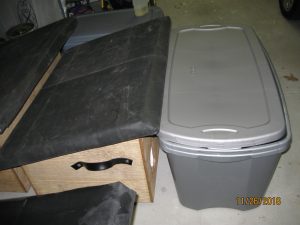
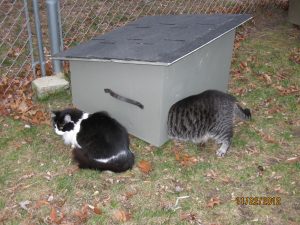
We always need help from persons willing and able to build some shelters!
We also need donations of 1/2 inch plywood (preferably exterior plywood), insulation, luan, 3-4 inch hinges, and rubber roofing. Please call 845-7888 if you have scrap items to donate!
Winter Shelters for Feral Cats
Winter is brutal for homeless cats. They need help throughout the winter months to find shelter that provides them protection from cold and wet weather. Without a good shelter, cats may become ill, and may suffer from frostbite on their ears, nose and paws. There are many ideas and designs available for winter cat shelters, but all good designs share two qualities: strong insulation and minimal air space. The insulation is needed to trap the cats’ body heat. Minimal air space is necessary so that cold air doesn’t fill the empty space and chill the cats. Straw is the best insulating material to use inside the shelter. Blankets or towels will become wet, will freeze and draw body heat away from the cats. Cats will cozy or burrow into straw and keep their body heat from escaping. Some designs suggest using styrofoam shipping containers, but caution is urged because cats often scratch them and particles may be ingested.
Community Cats Volunteers Help Build:
Community Cats TNR volunteers have been building the Alley Cat winter cat shelter shown in the photo. It is constructed of 1/2” plywood, has a 5” x 6” opening, double walls to allow for insulation between, a sloped and shingled or rubber roof, and a wind block just inside the entrance. Cats enter the shelter, go around the wind block, and cuddle into the straw interior. Volunteers have experimented and modified the design provided by Alley Cats to add roof insulation and rubber roofs, and a two-story design with compartments. More photos can be found in the newsletters found on the NEWS tab.
Another Popular Shelter:
Another popular shelter can be assembled using a large and a small storage bin. Blue board or fiberglass insulation can be placed below, above and around the interior “box” which is lined with plenty of straw. Entrance holes approximately 6” in diameter can be cut on one end of the long side of the outer and inner storage bins so the entrances line up. The two boxes can then be connected with 6” circular drainage tubing.
Dog Houses:
Dog houses may be modified by making the opening smaller, and large dog houses may be modified to reduce air space by designing “compartments” inside.
Buildings:
Allowing cats an entrance into an outbuilding will provide excellent protection from the elements, especially if you also add one or more small corners of straw, perhaps in a wood or cardboard box, under a tarp, etc.
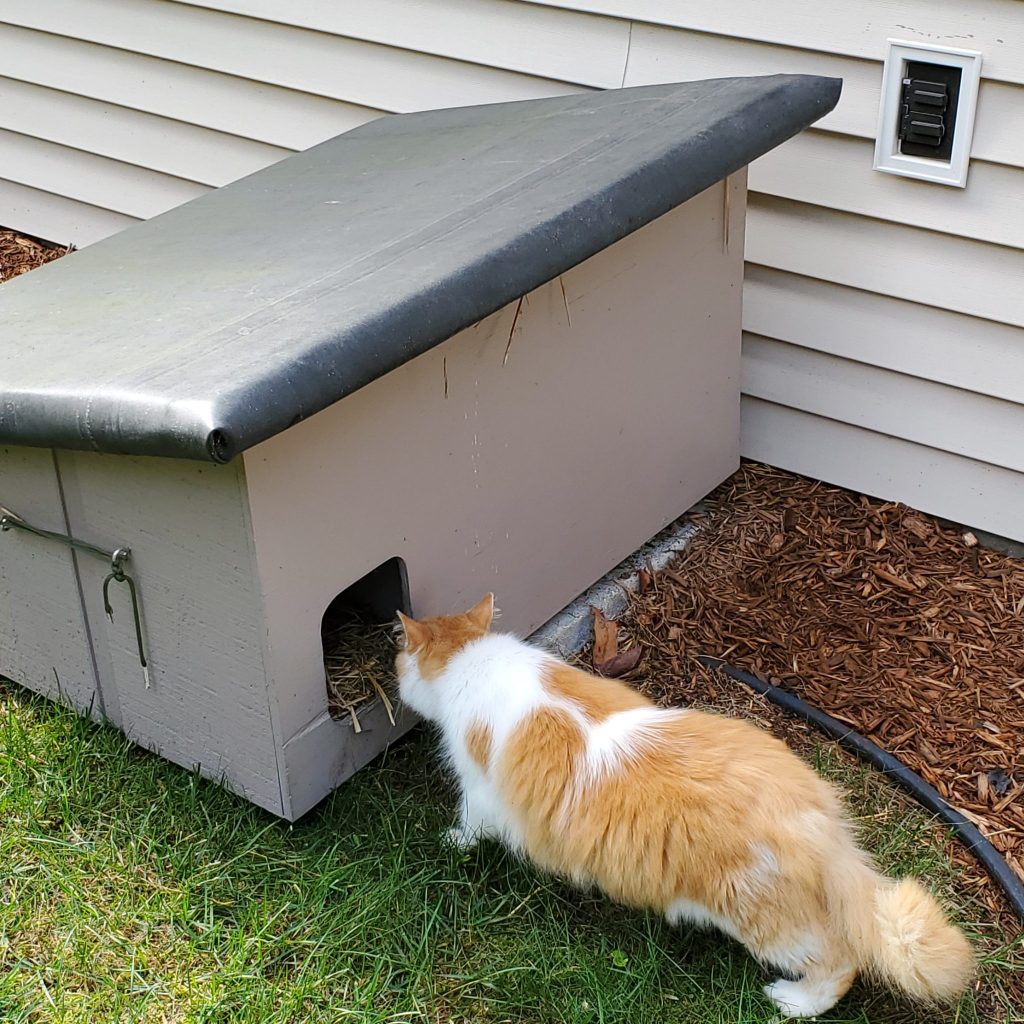
To Learn More About Winter Feral Cat Shelters:
Please Visit: https://www.neighborhoodcats.org/how-to-tnr/colony-care/feral-cat-winter-shelter
To Build your Own Feral Cat Shelter:
Visit https://www.alleycat.org/resources/feral-cat-shelter-options-gallery/
You’ve found some newborn kittens and you don’t know what to do. Click on the link below to go to a very comprehensive guide provided by Alley Cat Allies. It will help you make the decision about disturbing the kittens, or not, plus how to care for them if you do need to save them.
https://alleycat.org/community-cat-care-category/cat-care/kittens
Make check payable to COMMUNITY CATS TNR and mail to:
Community Cats TNR
P.O. Box 384
Ludington, Mi 49431
Credit card donation
To donate using a credit card, click on the link below and complete the form provided by Network for Good:
Community Cats TNR Page on nfggive.org
Community Cats TNR is a 501c3 non-profit public charity. Donations are tax exempt to the extent provided by law.
Consider donating dry or canned cat food by dropping off in the collection box at Family Fare (formerly Shop N Save). This food is provided to caregivers who are feeding homeless cats – many times a LOT of cats – and they appreciate the help! Purina Cat Chow (blue bag) is a favorite!
Trap/neuter/return is a humane, non-lethal alternative to trap and kill.
Trap/neuter/return (TNR) is a comprehensive management plan in which homeless, free-roaming (community) cats are humanely trapped, evaluated and sterilized by a licensed veterinarian, treated for parasites, vaccinated against rabies, and then returned to their original habitat.
In the long term, TNR lowers the numbers of cats in the community more effectively than trap and kill. Good Samaritans in neighborhoods all across the country provide food, water and shelter for community cats and TNR provides a non-lethal, humane way to effectively manage these community cat populations. In some programs, friendly cats or young kittens are customarily pulled from the colony and sent to foster facilities for socialization and, eventually, placement into forever homes. Stopping the breeding and removing some cats for adoption are more effective than trap and kill in lowering the numbers of cats in a community long-term.
The benefits to both cats and communities are numerous …
There are numerous benefits to TNR. For instance, TNR significantly reduces shelter admissions and operating costs. These programs also create safer communities and promote public health by reducing the number of unvaccinated cats. TNR programs also improve the lives of free-roaming cats: When males are neutered, they are no longer compelled to maintain a large territory or fight over mates, and females are no longer forced to endure the physical and mental demands of giving birth and fending for their young. Additionally, fewer community cats in shelters increases shelter adoption rates as more cage space opens up for adoptable cats. Furthermore, sterilizing community cats curtails population growth while alleviating nuisances.
Another beneficial component to TNR is the impact these programs have on animal control officers and shelter workers. Job satisfaction among these workers increases tremendously when the job does not entail unnecessarily destroying healthy animals for the purpose of convenience. This increased job satisfaction results in less employee turnover and an overall improved public image of the shelter itself. The reduction in euthanasia and animal admissions also provides more time for staff and volunteers to care for resident animals and give personal attention to potential adopters.
Equally Important:
TNR programs allow animal control facilities to take advantage of numerous resources typically unavailable to shelters that employ traditional trap-and-kill policies. Understandably, people are rarely inclined to volunteer for programs that fail to make them feel good about themselves. Through the implementation of TNR, volunteers know they are making a difference in the lives of the animals, and the community is benefiting from their charitable efforts. Volunteers can help trap cats and also assist animal control in locating other cats in need of TNR services. Commonly referred to as caregivers, these volunteers also feed and monitor the health of the individual cats and the colony, when applicable, once the cats are returned. Frequent monitoring is an invaluable component of successful TNR programs because caregivers can easily identify new cats who join the colony so they, too, can be sterilized, vaccinated and ear-tipped. Another component of a well-managed TNR program is the collection of critical data that can be used to seek grant funding for expansion of current TNR programs.
All unidentified cats who roam off their property are treated equally …
TNR volunteers and/or veterinarians will typically examine all incoming cats for owner identification. In most programs, unidentified animals are treated as if they are part of the TNR program and are physically evaluated, sterilized, vaccinated, ear-tipped and returned to their territory, where they can easily be reunited with their owners. Sterilizing owned cats who roam off their property and frequent community cat colonies is an important component to the success of any TNR program, since all free-roaming, unsterilized cats contribute to the overpopulation problem.
TNR is a practical solution to the failed trap-and-kill policy …
Lethal control has been used for more than three decades, and given the current problem of large populations of free-roaming cats, it is obvious that killing as a form of animal control does not work. Equally important, killing homeless animals as a means of population control is publicly unpalatable. By contrast, TNR puts an end to this perpetual cycle of death and makes it possible to maintain a colony at a relatively stable number of sterilized cats, who are unable to breed and multiply.
Populations rebound to previous levels following trap and kill …
Every habitat has a carrying capacity or, more specifically, a maximum species population size that can be sustained in that habitat. This carrying capacity is determined by the availability of food sources, water, shelter, and other environmental necessities. When a portion of the sustainable population is permanently removed and the availability of resources is unaltered, the remaining animals respond through increased birthing and higher survivability rates. Because of this biological certainty, trapping and removing cats from any given area does little more than ensure that the cat population will rebound to the same level as before, necessitating additional trapping and killing. While lethal control may arguably rid an area of cats temporarily, it is not an effective long-term solution because new cats will quickly fill the vacated area and breed, resulting in a perpetual cycle of killing.
Communities can save taxpayer money with TNR …
The city of Jacksonville, Florida, is a fine example of an area that has capitalized on non-lethal alternatives for controlling free-roaming cats. Over a three-year period (2007-2010), Jacksonville saved approximately 13,000 lives and $160,000. Equally important, feline nuisance complaints decreased during this period.
The Feral Fix Program in Salt Lake City, Utah, has also proven to be quite successful. From 2008 to 2010, Salt Lake City’s “save rate” of cats improved 40.4 percent, equaling a total cost savings of approximately $65,000. Shelter cat intake for the years 2009-2010 decreased 21.8 percent. During this same period, there was no increase in feline nuisance complaints.
Communities can save money with TNR, but the cost savings are undoubtedly location-specific and involve taking into account numerous variables for an accurate calculation. The immediate savings many communities experience are a result of tapping into volunteer support and other resources (e.g., private donations) that come from implementing a humane TNR program. Cost savings fluctuate based on the type of TNR program implemented, the extent of animal control involvement, the volunteer base available and the community’s support of TNR programs. The point that needs to be stressed, however, is that over time, through attrition and sterilization efforts, fewer cats will be breeding and contributing to the population growth. Fewer live animals to contend with inevitably means a decrease in the demand on taxpayer dollars.
Until a TNR program begins, it is difficult to calculate accurately how much money will be saved. However, other benefits are equally important. A successful TNR program can improve the public image of a town, which may add to economic development. Employee satisfaction within the shelter and animal control facilities is also a huge asset and contributes to a positive image of the community. The hometown pride and enthusiasm generated from supporting a non-lethal, practical and effective solution to a community problem must be factored into the equation, even though it doesn’t provide precise numbers in terms of cost savings.
Non-lethal deterrents for cats are effective and easily accessible …
There are numerous cat deterrents available on the market today. “How to Live with Cats in your Neighborhood” https://www.alleycat.org/community-cat-care/humane-deterrents/ provided by Alley Cat Allies provides a variety of methods to deter cats from gardens.
It’s bad public policy to criminalize kindness …
Feeding bans are notoriously ineffective primarily because they are impossible to enforce. Also, human nature rarely allows someone to sit idly by while an animal suffers. When a starving animal appears, compassion prevails. Consequently, people will not adhere to an ordinance discouraging the feeding of animals in need, and criminalizing kindness is just bad public policy.
Hungry cats can continue to reproduce, which further undermines the intent of most feeding prohibitions. Equally important, feeding bans jeopardize the ongoing sterilization and vaccination services provided by caregivers who diligently maintain and monitor cat colonies in the community. It is also important to note that once feeding by humans is prohibited, hungry cats are forced to physically compete with wildlife over available, natural food sources.
There could be liability for towns or municipalities that DON’T implement TNR programs …
Many free-roaming cats are unsocialized and tend to avoid people whenever possible. This lack of human contact minimizes the likelihood of liability or negligence that may result from human exposure. Also, in a TNR program, community cats are vaccinated against rabies so the probability of a person being severely injured is quite remote.
Liability should not be an issue for towns or municipalities that implement TNR programs for the purpose of reducing cat populations, protecting public health through vaccination efforts, or resolving nuisance complaints. These are all state interests worthy of government involvement. Also, animal owners are responsible for any alleged damage caused by their animals’ activities or behavior. In the case of community cats, there are no owners, so there is nowhere for liability to be placed.
The question that often comes up when the issue of liability is raised is this: What happens if a town fails to adopt a TNR program, and a child gets bitten by an unvaccinated, free-roaming cat? Is the town then liable because it rejected TNR, since this failure to act may be deemed negligence? Again, it can be argued that the cat is not owned; however, the obvious concern in this scenario is that the outcome can potentially be far more tragic.
An ordinance grants credibility to any TNR program …
When crafted properly, a TNR ordinance establishes reasonable standards and defines duties for those individuals instrumental in implementing a community cat program. This type of legislation grants credibility to TNR, promotes community involvement and encourages community cat caregiver cooperation. Equally important, well-crafted legislation will insulate community cats from licensing requirements, feeding bans, pet limits, or other punitive laws that often impede the progress of sterilization efforts and public health protection. Grant funding is available for TNR programs, specifically in those situations where TNR ordinances have been adopted, as this legal assurance speaks volumes about the level of community support and involvement.
TNR means fewer cats, which means fewer threats to birds. Other factors pose more serious threats to bird populations …
According to Cornell Lab of Ornithology, the largest threat to birds is loss (or degradation) of habitat, which results from human development and agriculture. Other significant hazards to bird populations include chemical toxins and direct exploitation from hunting and capturing birds for pets.
There are no studies that show conclusively that pet cats are responsible for declines in wildlife populations. In fact, according to Yolanda van Heezik, who wrote “A New Zealand Perspective” (The Wildlife Professional, Spring 2011), “It’s unclear as to what extent declines of wildlife can be attributed to cats versus other human-related modifications to landscapes.” Although no studies support the misleading claims that cats are destroying songbird populations, there’s no disputing that cats do in fact kill birds. The point that must be highlighted, however, is that fewer cats mean less bird predation. That being the case, TNR should not be condemned because of potential wildlife predation, but rather embraced so that free-roaming populations can be curtailed as efficiently as possible to minimize potential predatory behavior.
Trapping and killing homeless animals is ineffective in reducing free-roaming populations …
TNR programs are being adopted by towns and municipalities across the nation out of necessity and good common sense. As evidenced by three decades of trapping and killing, lethal means for controlling homeless animal populations is not the answer. This paradigm shift is being seen on many municipal levels as budgets continue to be slashed in the animal control industry. This evident need for better tools to handle animal control issues has led to a philosophical shift in the animal control industry itself. In fact, according to Mark Kumpf, 2010 president of the National Animal Control Association, “The cost for picking up and simply euthanizing and disposing of animals is horrendous, in both the philosophical and the economic sense.”
Cats will be abandoned with or without TNR …
Unfortunately, cat abandonment does occur. In fact, cats have been abandoned for as long as people have had pet cats, which is why TNR is necessary today. These periodic abandonments, however, will not derail the overall success of a TNR program because cat colonies can absorb the occasional newcomer yet still show a significant population reduction when the majority of the animals are sterilized.
It’s also important to stress that maintaining a local TNR colony is likely not the determining factor behind whether someone abandons a pet or not. Surely there are a variety of other issues that factor into this irresponsible behavior. However, efforts should be made to place feeding stations in out-of-the-way locations to minimize the likelihood of desperate people illegally abandoning their pet cats. Other strategies should also be employed to further reduce potential abandonment, such as posting signs about abandonment ordinances at high-profile cat colonies.
Humans contracting a disease from a cat is quite unlikely …
According to the Centers for Disease Control and Prevention (CDC) website, people are not likely “to get sick from touching or owning a cat.” As stressed above, free-roaming cats tend to avoid human contact. This natural avoidance of humans makes the likelihood of disease transmission quite remote. The CDC also provides simple health tips to minimize potential exposure, such as washing hands with soap and water after touching feces or after being scratched or bitten. The agency also recommends that cats be vaccinated against rabies — which is a key component to most TNR programs.
Rabies and toxoplasmosis are two diseases often raised during discussions about free-roaming cats. It’s important that both of these serious human health threats be put into proper perspective. According to the CDC website, rabies in cats is extremely rare (cdc.gov/rabies/location/usa/surveillance/domestic_animals.html). In fact, only about 1 percent of the cats tested in 2009 tested positive. Also, out of the four rabies cases reported to the CDC in 2009, none of them involved cats. The possibility of humans contracting toxoplasmosis from cats is also quite minimal. In fact, according to the CDC, “People are probably more likely to get toxoplasmosis from gardening or eating raw meat.”
Free-roaming cats can live long, healthy lives …
Free-roaming cats often live long, healthy lives. According to a study conducted by Dr. Julie Levy (Levy, Gale and Gale, 2003) at the University of Central Florida, the majority of cats (83 percent) in the 11 cat colonies studied were present on the campus for more than six years. It’s quite likely that many of the observed cats far exceeded that life span, since approximately one-half of the free-roaming cats first observed in the study were already adults, so their true ages were unknown. Furthermore, according to Levy, the body weights of free-roaming cats, when compared with pet cats in previous studies, found “no significant differences” and “commonly, free-roaming cats were in adequate body condition.” Also, similar to owned cats, neutering free-roaming cats resulted in an increase in body weight and overall body condition.
The findings regarding the health of free-roaming cats were quite similar in other studies. For instance, during the years 1993 to 2004, seven TNR organizations throughout the nation collected data on 103,643 free-roaming cats examined in spay/neuter clinics. Less than 1 percent of these animals needed to be euthanized because of debilitating conditions, trauma or infectious diseases (Wallace and Levy, 2006). The one program that tested for FeLV and FIV reported an overall infection rate of 5.2 percent, which is similar to previous studies that reported results for both pet and feral cats.
Utah towns and municipalities are now empowered to implement humane and cost-effective policies to control free-roaming cat populations …
Utah’s Community Cat Act, adopted in 2011, is a significant piece of legislation that allows towns and municipalities to implement humane and effective policies to control free-roaming cat populations. The Community Cat Act defines a community cat as “a feral or free-roaming cat that is without visibly discernable or microchip owner identification of any kind, and has been sterilized, vaccinated and ear-tipped.” This act provides legal protection to caregivers and sponsors by stipulating that they do not have “custody” of the animals. Consequently, returning cats to their original habitat following sterilization cannot be construed as abandonment.
This legislation also exempts community cats from licensing requirements and feeding bans, providing yet another level of legal protection to the good Samaritans who care for them. Equally important, cats who are eligible for a community cat program are exempt from the mandatory five-day hold period, which is a significant cost savings for animal shelters and taxpayers alike. This provision is also invaluable to the health of free-roaming cats, who customarily endure a great deal of unnecessary stress while housed in shelter environments.
The FAQ information above was retrieved from: Best Friends Animal Society • (435) 644-2001 • https://bestfriends.org/ • network.bestfriends.org
Below are businesses in the West Michigan Guides “Featured Business” section. We encourage you to support small businesses throughout West Michigan. Thank you!

Since 1962, this is Oceana County’s original 18-hole public course. Oceana Golf Club is known for having the best greens in the area.

The Law Office of J. Cleaver PLLC specializes in estate planning, small estate administration, small businesses, and law firm document production.

Pierrot Hair Design in downtown Ludington specializes in hair cuts, color, highlighting, keratin hair-straightening, and perms.

Stay at a top-rated hotel in Ludington. Hotel brands include Holiday Inn Express & Suites, Best Western Lakewinds, and Comfort Inn.

Enjoy a drink or light meal at T.J.’s Pub, inside the lower level of the cozy and historic Ramsdell Inn, downtown Manistee.

The Market is located at Stiles and US-10. It’s a one-stop shop for fresh produce, landscaping products, farmhouse decor, and more.

Located within the Manistee National Forest, Cabin Fever Round Lake Resort specializes in relaxing vacations and great camping experiences.

Nestled in the quaint harbor village of Pentwater, Petri Gallery is a feast for the art lover’s eyes. Now with 2 locations.

Ludington Taxi has existed for over 15 years and is commercially insured. They offer friendly, 24/7 service, and clean, well-run vehicles.

Beautiful 27 hole, 6900 yard par 72 Colonial, and 9 hole, 1600 yard par 30 Heritage. Huge driving range, food & refreshments available.